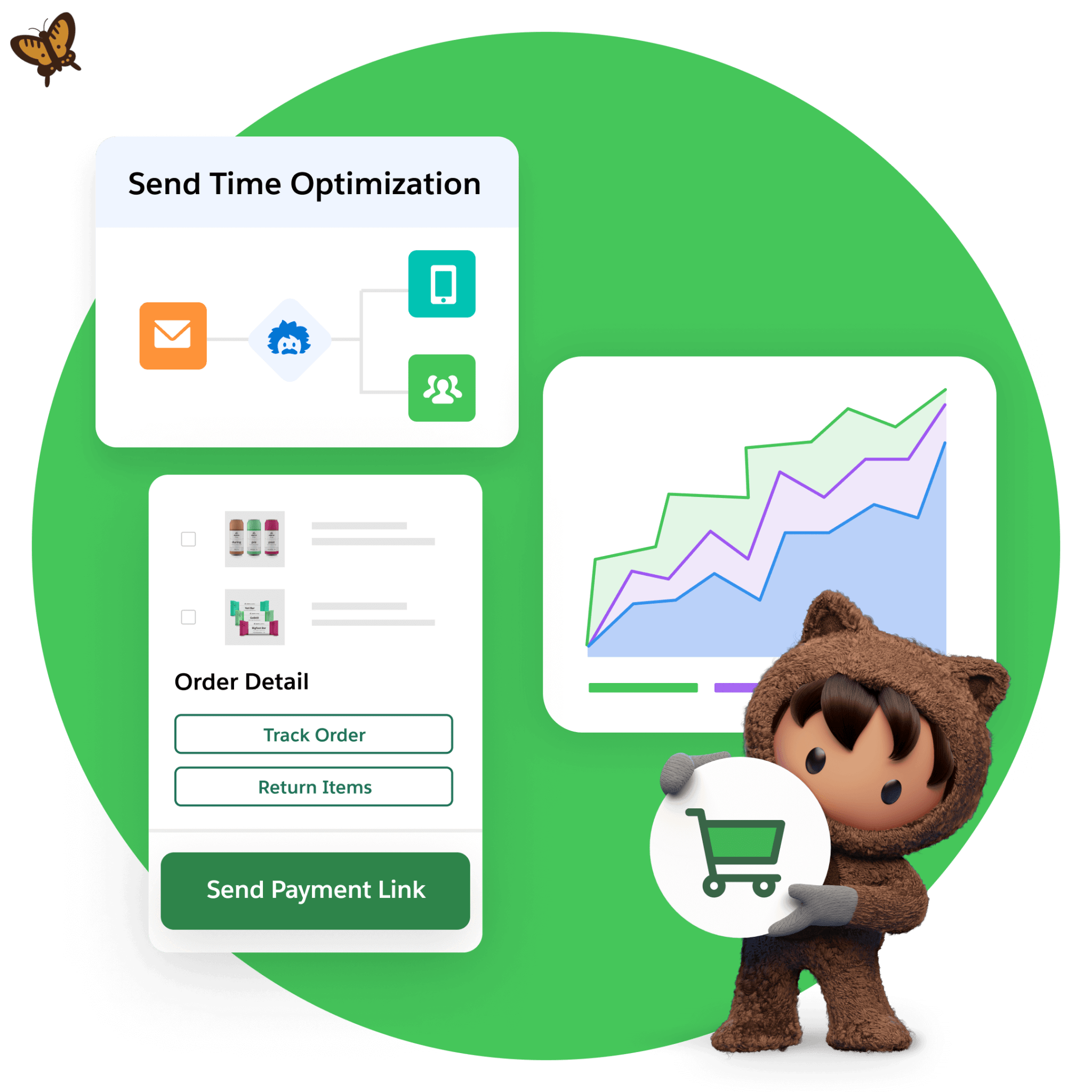Everywhere you scroll, there’s something to buy — and more people are buying with just a tap. Whether it’s checking email or browsing social media, digital storefronts are all around us. In fact, 53% of customers prefer to interact with businesses online, and 59% make purchases directly through social platforms, according to the latest State of Commerce Report.
With so many ways for people to shop on their phones, this might be the perfect time to start your own ecommerce business. But how do you go from idea to execution? This blog will walk you through the best ecommerce business ideas and show you how to get started.
What you’ll learn:
- Identifying your ecommerce niche
- Choose your (own adventure) market
- Explore ecommerce business models
- Ecommerce challenges to overcome
- Turn these ecommerce business idea into great ones
Identifying your ecommerce niche
If you’re a small and medium-sized business (SMB) owner, one of the most important steps in starting your ecommerce journey is finding the right niche. That means focusing your efforts instead of trying to sell to everyone. When you target a specific group of customers, it’s easier to stand out and build stronger connections in a competitive market.
Look for gaps in the marketplace. Ask yourself: What are people missing? How can I offer something different? And most importantly, what do I care about? Passion plays a big role in long-term success.
For example, instead of selling just any sneakers, you might focus on eco-friendly ones made with ethically sourced fabrics and renewable materials. That kind of clear, meaningful focus can help your business connect with customers who share your values.
Questions to ask before you get started
Before diving into your ecommerce niche, it’s worth taking a step back to ask a few important questions. These will help you validate your idea and set a strong foundation for your business.
Sell More With Salesforce For Small Business
Is there a demand for your product or service? You want a niche that has interest but isn’t overcrowded. If there’s too much competition, it might be hard to stand out. But if demand is too low, it may not be sustainable. Aim for a balance — something people want, but with room for your business to grow.
What’s your unique selling proposition? Think of the ways your product or service stands out from the crowd as you form your unique selling proposition (USP). Clearly define what sets you apart, whether it’s exceptional customer service, product quality, or a specialized focus.
What are you passionate about? If you’re genuinely interested in something — whether it’s pet costumes or writing code — you’re more likely to stay motivated and build a better business. Consider your strengths. What industries or skills do you already have experience in? Your existing knowledge can give you a competitive edge in a crowded market.
Are there gaps in the market? Do a deep dive and study your competition. Analyze their practices to see what they’re doing right — and where they’re falling short. Check their reviews and read customer feedback. If there’s a common thread of complaints, figure out if that’s something you can address. Find an audience neglected by mainstream competitors, or look at a popular product or service and consider how you can put a new spin on it.
What’s trending right now? Use online tools to track industry trends and identify emerging markets. Read newspapers and trade publications to see what’s being covered by reporters in your industry. Check out social media to see what products or services people are raving about. Don’t be afraid to explore evolving technology that could create new demands for your products or services.
Is the niche profitable? At the end of the day, your business needs to make money. Check if the products or services in your niche offer healthy profit margins. Look at sourcing, pricing, and potential growth over time. Some niches may have high demand but thin margins, so be sure to run the numbers.
Watch the webinar: Start Selling Online with Storefronts in Starter, Pro, and Foundations
Research your business idea in 10 steps
The old saying “measure twice, cut once” applies just as much to launching an ecommerce business. A little extra time spent upfront on research can save you from major setbacks later — and might even prevent a costly mistake.
Here are 10 practical steps to help you validate your ecommerce idea before going all in:
- Analyze your target market to understand their needs and wants, along with their preferences and purchasing behaviors.
- Look at what similar businesses are offering. What products or services do they sell? What are their price points and marketing strategies? Learn from what they’re doing and find opportunities to do it differently or better.
- Conduct interviews with potential customers to validate their interest in your product or service. Understanding their pain points clarifies your offerings.
- Post a short survey on your website or social media channels to gauge interest. Keep it simple and focused on what customers want or expect from your product.
- Launch a landing page that showcases your ecommerce idea. Offer a call-to-action (CTA) button for customers to sign up for updates. If your customers have a positive response, you may be on to a terrific idea.
- Use platforms like Instagram, TikTok, or LinkedIn (depending on your audience) to showcase your idea. See how people engage with your posts. Likes, shares, and comments are early indicators of interest.
- Run a few ads on Google or social media to see if your target audience clicks through. Even a small budget can help you learn which messages resonate most.
- Get feedback on your idea from professionals in your industry. They may offer insights about your product or service that you’ve not previously considered.
- Test your idea with a small batch of products or a prototype to gauge interest before fully committing to the niche.
- Research keywords related to your product or service. This can help you identify what people are looking for online — and just how competitive those niches are.
Start selling online with Starter Suite
Set up your digital storefront, engage customers, and sell more using a commerce-ready platform with integrated tools for every sale.

Choose your (own adventure) market
It’s a bit like choosing your own adventure, but in the real world. With evolving times, several niche markets have emerged in recent years. These categories are thriving because they meet specific consumer needs and capitalize on emerging trends. They also highlight how personalization, sustainability, and technology are reshaping the ecommerce world.
Here are a few trending niche markets:
Green products and services: The effects of climate change and other environmental concerns are driving demand for green products and services. Brands that focus on zero-waste packaging, sustainable sourcing, and ethical manufacturing can win over clients who don’t prioritize sustainability.
Resale marketplaces: The resale boom is real, especially in fashion and luxury. Today’s thrift is chic, and budget-conscious shoppers love the thrill of scoring high-end, secondhand items at a fraction of the cost. Vintage, upcycled, and authenticated resale goods are all on trend.
Subscription box services: Curation is king. Subscription boxes for everything from skincare to snacks to pet toys continue to grow in popularity. The appeal? Surprise, convenience, and a personalized customer experience that keeps shoppers coming back month after month.
Artisanal products: Turned off by big box stores, many consumers are seeking unique products made by artisans and crafters. A range of online selling platforms have made it easier for shoppers to buy artisanal products like fruit preserves, candles, and hand-knit sweaters.
Health and wellness: With the rise of alternative health practices, products that focus on specific health needs are a growing market. This niche can include things like organic supplements, CBD products, personalized vitamin services, and holistic health supplements.
Direct-to-consumer brands: Just like it says in its name, direct-to-consumer (DTC) brands cut out the middleman, creating a direct relationship with consumers. Selling things like eyeglasses, mattresses, and razor blades, these DTC brands use social media marketing to get the word out about their products — and build loyal communities.
Online education: With the rise of remote work, many schools have raced to fill the need for online education. These virtual institutions of higher learning offer online courses, e-learning platforms, and digital products aimed at improving skills and professional development.
Pet products and services: Pet parents are splurging more than ever — from premium food and wellness supplements to smart feeders. The pet industry is booming, and niche products that treat pets like family are in high demand.
Explore ecommerce business models
An ecommerce business model is a framework that outlines how a company sells products or services online and makes money. It covers what you sell, who you sell to, and how you attract and serve your customers.
Let’s say that you love animals — and you love the fact that pet owners in the U.S. spend more than $136 billion on their furry, feathered, and scaly friends per year, according to Forbes. There’s a wide variety of business models that can cater to pets — whether it’s custom dog sweatshirts printed on demand or dog food sold in bulk to commercial kennels.
No matter what online business idea you pursue, consider which ecommerce model might be your best approach:
Model 1: Print-on-demand
Print-on-demand is a business model where products, such as books, clothing, or artwork, are only printed and produced once an order is received, eliminating the need for inventory and reducing upfront costs.
With a print-on-demand model, businesses can offer highly customizable products with relatively low upfront costs. Customized products are created after the order is placed, reducing potential problems with inventory risk. This model is especially popular for personalized apparel, art, and accessories.
Model 2: Private label
Private label refers to the practice of manufacturing or purchasing products that are branded and sold under a retailer’s own brand name rather than the manufacturer’s, allowing the retailer to have control over pricing, marketing, and product exclusivity.
Manufacturers partner with companies to create a branded product with minimal investment in product development. The main advantage of this model is that you can sell products without holding inventory. It’s also quick to bring products to market, and (relatively) easy to scale. Many ecommerce brands use this model by buying unbranded products and applying their label to clothing or packaging.
Model 3: D2C ecommerce
Direct-to-Consumer (D2C) commerce is a business model where companies sell their products directly to customers, bypassing traditional retail intermediaries. This approach allows you to have more control over your brand, customer experience, and data. By eliminating middlemen, D2C companies can often offer better prices and more personalized services.
For small businesses, this model can be particularly advantageous as it helps build a loyal customer base and scale operations efficiently. Salesforce provides powerful tools and platforms that enable small businesses to manage and grow their D2C commerce, offering everything from customer relationship management (CRM) to ecommerce solutions, making it easier to connect with customers and drive sales.
Model 4: Dropshipping
Dropshipping is a retail fulfillment method where a store doesn’t keep the products it sells in stock. Instead, when a store sells a product using the dropshipping model, it purchases the item from a third party (like a manufacturer or wholesaler) who ships it directly to the customer. This means the store doesn’t have to worry about inventory management, storage, or shipping logistics. It’s a popular business model for online retailers due to its low overhead and flexibility.
Model 5: Crowdfunding
Crowdfunding is a way to raise money for a project or idea by asking many people to contribute small amounts, usually online. Instead of getting a loan or finding big investors, you can reach out to a large group of people who might be interested in what you’re doing and want to support it with a little bit of money.
Sourcing money from donors can be especially effective for innovative or one-of-a-kind products. Products are then marketed and sold before they are made, allowing you to validate demand before sinking your life’s savings into the venture.
Model 6: Affiliate marketing
Affiliate marketing is a business model where an affiliate earns a commission for promoting and driving sales for another person’s or company’s product. It’s essentially a referral system where the affiliate searches for a product they like, promotes it to others and earns a piece of the profit from each sale they make.
The main advantage of this model is the low barrier to entry, the lack of need for inventory or product creation, and it allows you to build a business around your expertise or niche interests.
What can your small business do with marketing automation on
Salesforce CRM?



Model 7: Cause-based brands
A cause-based brand is a company that aligns its business operations and marketing efforts with a social or environmental cause, aiming to make a positive impact beyond just profit. These brands integrate their chosen cause into their core identity and actively support it through various initiatives, such as donating a portion of profits, advocating for awareness, or implementing sustainable practices. By doing so, they appeal to consumers who share similar values and want to support businesses that contribute to the greater good.
Model 8: Freemium model
A freemium model offers a product or service for free while charging for premium features or upgrades. Common for software, tools, or apps, the freemium model allows you to build a large user base, with a percentage of them converting to paid users over time.
Model 9: B2B ecommerce
Business-to-business (B2B) ecommerce refers to the sale of products or services between businesses through an online platform. This model’s advantage for B2B commerce is that most companies need a constant supply of office products and business solutions, which often leads to consistent sales.
Ecommerce challenges to overcome
Starting an ecommerce business comes with its own set of hurdles. Unlike opening a physical store, you’re building a digital storefront that needs to work smoothly and make a strong first impression. Here are some common challenges and how you can overcome them:
1. Getting people to your site
It’s tough for new ecommerce sites to stand out. In fact, 75% of people never scroll past the first page of search results. To boost your visibility:
- Invest in search engine optimization (SEO) to improve your product page rankings.
- Run paid ads to get in front of your audience quickly.
- Team up with influencers to tap into established communities.
2. Abandoned shopping carts
According to research, more than 70% of online shoppers abandon their carts before buying. To encourage them to complete the purchase:
- Streamline your checkout for fewer steps and better results.
- Offer guest checkout for convenience.
- Send friendly email reminders when a cart is left behind.
3. Earning customer trust
Nearly half of online shoppers say lack of trust keeps them from buying. You can build credibility by:
- Showcasing customer reviews and testimonials.
- Providing fast, friendly customer support using artificial intelligence (AI).
- Using clear return and refund policies.
4. Handling shipping and logistics
Shipping delays, high costs, and complex logistics can negatively impact the customer experience. To stay on top of it:
- Work with trusted shipping partners.
- Give customers a range of shipping options.
- Be upfront about delivery times.
The bottom line? Choosing the right ecommerce platform is key for your small business to grow. We advise choosing an ecommerce platform made for small businesses, based on ease of use, scalability, and features that suit your needs. It should reflect the spirit of your business with clear, cohesive branding.
Just get started.
No matter where you are on your journey as a small business owner, you can get started with Starter Suite — the all-in-one AI CRM your SMB needs.

Turn these ecommerce business ideas into great ones
Your ecommerce business idea has limitless potential. To be successful, your idea requires finding the right niche, market research, and the right tools — and then testing it out before launch. With the right tools, you can confidently take your first step (and every step after that). Salesforce gives you everything you need in one place, from AI-powered CRM to marketing, sales, service, and commerce tools, all working together to help you grow faster.
All of this can be done with a CRM powered by AI that connects marketing, sales, service, and commerce in one platform. This foundation will help your ecommerce business flourish and grow. Get set up for success with your ecommerce business from day one with Starter Suite.
So why not start strong? Begin your journey with the Starter Suite today. Looking for more customization? Explore Pro Suite. Already a Salesforce customer? Activate Foundations and try out Agentforce today.
AI supported the writers and editors of this article.




































